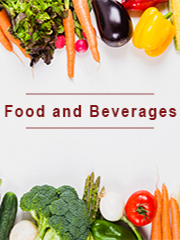Ready Meals have been introduced by the vendors as an alternative meal that is quick and cost-effective, which just requires heating before consumption. Ready Meals is packaged and is available in quantity for single or two serving. Due to the hectic lifestyles, consumers prefer Ready Meals that reduce the preparation or cooking time, thereby leading to the growth of the overall market.
Ready-meals have been defined as pre-prepared main courses that can be reheated in their container, requiring no further ingredients, and needing only minimal preparation before consumption.
This report aims to provide a comprehensive presentation of the global market for Ready Meals, with both quantitative and qualitative analysis, to help readers develop business/growth strategies, assess the market competitive situation, analyze their position in the current marketplace, and make informed business decisions regarding Ready Meals. This report contains market size and forecasts of Ready Meals in global, including the following market information:
Global Ready Meals Market Revenue, 2018-2023, 2024-2029, ($ millions)
Global Ready Meals Market Sales, 2018-2023, 2024-2029, (M Units)
Global top five Ready Meals companies in 2022 (%)
The global Ready Meals market was valued at US$ 120770 million in 2022 and is projected to reach US$ 158110 million by 2029, at a CAGR of 3.9% during the forecast period. The influence of COVID-19 and the Russia-Ukraine War were considered while estimating market sizes.
Global Ready Meals key players include Nestle, ConAgra, Unilever, Kraft Heinz, etc. Global top four manufacturers hold a share over 10%.
Europe is the largest market, with a share about 35%, followed by Asia(Ex.China), and North America, both have a share about 50 percent.
In terms of product, Frozen and Chilled Ready Meals is the largest segment, with a share over 60%. And in terms of application, the largest application is Hypermarkets and Supermarkets, followed by Independent Retailers, Convenience Stores, etc.
We surveyed the Ready Meals manufacturers, suppliers, distributors and industry experts on this industry, involving the sales, revenue, demand, price change, product type, recent development and plan, industry trends, drivers, challenges, obstacles, and potential risks.
Total Market by Segment:
Global Ready Meals Market, by Type, 2018-2023, 2024-2029 ($ Millions) & (M Units)
Global Ready Meals Market Segment Percentages, by Type, 2022 (%)
- Frozen and Chilled Ready Meals
- Canned Ready Meals
- Dried Ready Meals
Global Ready Meals Market, by Application, 2018-2023, 2024-2029 ($ Millions) & (M Units)
Global Ready Meals Market Segment Percentages, by Application, 2022 (%)
- Hypermarkets and Supermarkets
- Independent Retailers
- Convenience Stores
- Others
Global Ready Meals Market, By Region and Country, 2018-2023, 2024-2029 ($ Millions) & (M Units)
Global Ready Meals Market Segment Percentages, By Region and Country, 2022 (%)
- North America
- US
- Canada
- Mexico
- Europe
- Germany
- France
- U.K.
- Italy
- Russia
- Nordic Countries
- Benelux
- Rest of Europe
- Asia
- China
- Japan
- South Korea
- Southeast Asia
- India
- Rest of Asia
- South America
- Brazil
- Argentina
- Rest of South America
- Middle East & Africa
- Turkey
- Israel
- Saudi Arabia
- UAE
- Rest of Middle East & Africa
Competitor Analysis
The report also provides analysis of leading market participants including:
- Key companies Ready Meals revenues in global market, 2018-2023 (Estimated), ($ millions)
- Key companies Ready Meals revenues share in global market, 2022 (%)
- Key companies Ready Meals sales in global market, 2018-2023 (Estimated), (M Units)
- Key companies Ready Meals sales share in global market, 2022 (%)
Further, the report presents profiles of competitors in the market, key players include:
- Nestle
- ConAgra
- Unilever
- Kraft Heinz
- Campbell Soup
- Hormel Foods
- The Schwan Food
- JBS
- Sigma Alimentos
- Iglo Group(Nomad Foods)
- Sisters Food Group
- Tyson Foods
- Fleury Michon
- Grupo Herdez
- Greencore Group
- Maple Leaf Foods
- McCain
- Advanced Fresh Concepts
Outline of Major Chapters:
- Chapter 1: Introduces the definition of Ready Meals, market overview.
- Chapter 2: Global Ready Meals market size in revenue and volume.
- Chapter 3: Detailed analysis of Ready Meals manufacturers competitive landscape, price, sales and revenue market share, latest development plan, merger, and acquisition information, etc.
- Chapter 4: Provides the analysis of various market segments by type, covering the market size and development potential of each market segment, to help readers find the blue ocean market in different market segments.
- Chapter 5: Provides the analysis of various market segments by application, covering the market size and development potential of each market segment, to help readers find the blue ocean market in different downstream markets.
- Chapter 6: Sales of Ready Meals in regional level and country level. It provides a quantitative analysis of the market size and development potential of each region and its main countries and introduces the market development, future development prospects, market space of each country in the world.
- Chapter 7: Provides profiles of key players, introducing the basic situation of the main companies in the market in detail, including product sales, revenue, price, gross margin, product introduction, recent development, etc.
- Chapter 8: Global Ready Meals capacity by region & country.
- Chapter 9: Introduces the market dynamics, latest developments of the market, the driving factors and restrictive factors of the market, the challenges and risks faced by manufacturers in the industry, and the analysis of relevant policies in the industry.
- Chapter 10: Analysis of industrial chain, including the upstream and downstream of the industry.
- Chapter 11: The main points and conclusions of the report.
